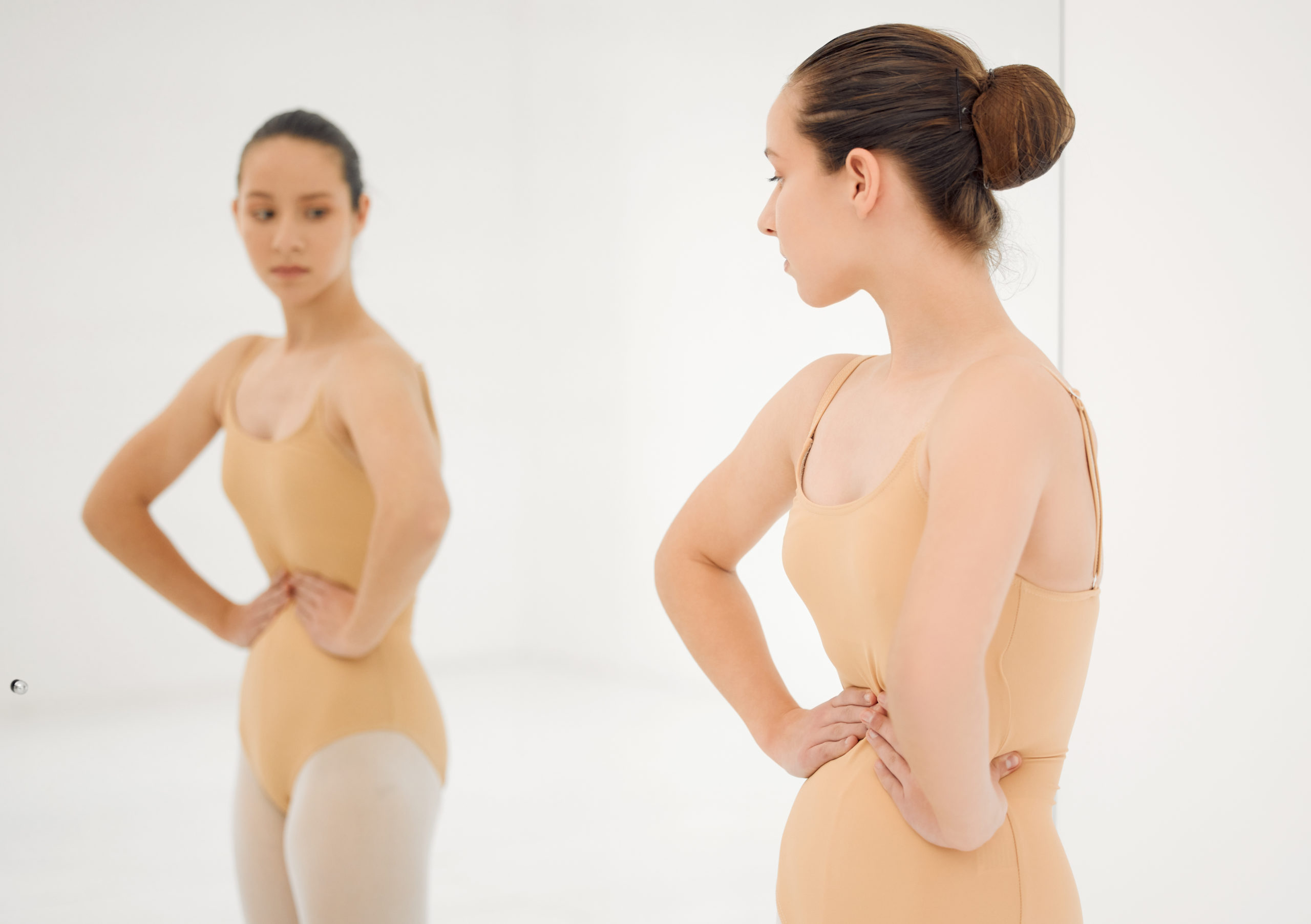
An unfortunate reality of teaching dance is that you will likely face signs of disordered eating or eating disorders among students. Research has shown that dancers are at least three times more likely to suffer from an eating disorder than the general population.
Once you have observed signs of an eating disorder in a student it’s easy to feel anxious—what are you supposed to do now? You want to support the student but may not feel like you have the resources. And what about the other dancers in the studio? Does the presence of a dancer exhibiting severe body dysmorphia and disordered eating cause them harm, as well?
You don’t need to be a medical professional to help your student; in fact, it is best if you don’t try to be. The best thing you can do for your student is to be prepared with resources, create solid policies for dealing with eating disorders, and act as an ally of their medical team.
Should a Dancer With an Eating Disorder Be Removed From Class?
Yes, and no. Experts agree that there isn’t a clear answer because of the nuance of each specific situation. Josh Spell, a licensed social worker working as the consulting mental health professional at Pacific Northwest Ballet, points out that we should look at an eating disorder as an injury, much like the physical injuries we feel more comfortable dealing with. “Usually, the steps with a physical injury are to have them dance as much as they can safely,” he says. “I think that removing them from the studio completely sends the message that we are afraid to acknowledge or deal with an eating disorder. My first suggestion is to treat this like a sprained ankle, or some other injury that dance teachers know more about.”
“Eating disorders are very complicated, and recovery is different for every person,” says Kristin Koskinen, a clinical dietitian who works with dancers. “We assume that the eating disorder is being triggered by the dance environment, but that may not be true. And in deciding to take them out of dance class, you may be removing them from their safe place.”
The reassuring news: Whether a dancer continues to participate in class despite their eating disorder should not be the teacher’s call. “Teachers are in a place of trust and responsibility, and they may be the first ones to notice changes in the dancer,” says Karen Sheriff, head of health care at The Royal Ballet School. “But no one expects the dance teacher to be a medical professional.” Ultimately, you’re not qualified to determine the best course of action to help a dancer treat or manage an eating disorder, but you do play a vital role in connecting them with the care they need and in establishing boundaries and practices to protect them and all the other dancers in the room.
Identifying the Problem and Building a Team
As an adult in the dancer’s life who sees them regularly (possibly more than their parents do), you have a responsibility to be aware of the signs of an eating disorder. You may notice that a dancer has become more withdrawn, is frequently trying to cover their body with baggy clothing or is avoiding eating in front of others. It is important to know that a dancer can be suffering from an eating disorder without appearing very skinny. “When it comes to identifying an eating disorder, being emaciated is what most people are looking for,” says Koskinen. “Only 6 percent of the population present as medically underweight. So, if that is the only thing that we are looking for, we are going to overlook many of the students who have disordered eating or an active eating disorder.”
Our experts agree that managing an eating disorder requires an interdisciplinary team—a therapist, a nutritionist/dietitian and a medical doctor. Dance schools and institutions have access to these professionals to varying degrees. Even if you don’t have an in-house medical team, you can create relationships with providers in your area—ideally, before you need them. It will benefit you and your dancers if you have a list of professionals for referrals in these specialties at the ready.
Once you have found a team that you can refer a dancer to when you have concerns, you need to think about how to start the process. Physicians are given very little training on eating disorders at medical school, warns Koskinen. She has seen some primary care physicians write off the signs of an eating disorder as being normal or common for an athlete. “A dietitian or a therapist is going to be scanning the horizon for an eating disorder and is going to be more likely to pick it up,” she says.
Once the dancer has a team in place to support them, you can ask for notes from their providers to indicate that they are medically cleared to be dancing (or to what extent), the same way you would for a physical injury.
Expressing Concern and Creating Boundaries
While the course of treatment, and whether the dancer will continue to be in the studio, is not up to you, you still serve as an important member of the team working to support your student. The most difficult part of your role in this is expressing your concern. When you speak with the dancer, focus on your own observations about changes in their behavior, and use “I” statements: “I have noticed that you are focusing a lot on your appearance in the mirror, and you have been losing weight.” Sheriff suggests focusing on your care for the student (“We need you to be safe”).
This year PNB established a formal policy for managing eating disorders, implemented by Spell and PNB consulting dietitian Monica Van Winkle, in consultation with the Australian Ballet. The protocol is part of the PNB School handbook, beginning on page 26. “Last year when we would tell a dancer they have to prioritize going to these appointments over ballet class, the dancers felt like we were being punitive,” says Spell. “But now there is a clear policy, so it doesn’t feel as personal.” He adds that rolling this policy out to the teachers was imperative, so that they know what to do when they have a concern. Ultimately the teachers are more supported when there is a policy in place to support them. Spell says that also means that they are more likely to act when they are concerned about a student.
If your studio does not have a policy in place for the management of suspected or confirmed eating disorders, it is worthwhile to advocate that they create one. “The health professionals are there to help create the boundaries that will support the dancer,” says Spell.
Be Proactive to Prevent Eating Disorders
The most important role you play in the prevention of eating disorders is in the environment you create. “No diet talk and no weigh-ins,” says Koskinen. “Teachers should not be offering general advice about food or eating. Nutrition is a specific field, and unless you are licensed in your state you should not be giving advice. No discussion of ‘good’ versus ‘bad’ food.” It is important to note that weight may be an important factor in eating disorder recovery, but being weighed should be done exclusively by trained medical professionals.
What subtle cues is your studio sending about body type and weight? If the thinnest dancers are always getting the best roles or the most attention, that is being felt by others in the class. “What do the pictures you are putting up in the studio look like?” asks Spell. “How are you marketing the studio? What pictures are on the website? What might be unsaid that the dancers are picking up on?”
When a Dancer Won’t Accept Treatment
“You can’t force someone to seek help,” says Sheriff. She advises that you keep notes in a secure location, like a password-protected folder, to document your discussions with the dancer (and their parents, especially if they are a minor). It can be hard to tell a dancer who is not willing to use the resources they have been given that they cannot continue with your studio, but as Sheriff so aptly puts it, “We cannot collude with illness. We have a duty of care.”
Eating disorders are the deadliest of mental illnesses. And early intervention is the best indicator of a positive outcome. “It’s never easy, but we are looking at the longevity of a human being. It’s no longer just about dancing,” says Spell. “You are going to get parents that are upset and dancers who are in denial—that is what an eating disorder is. That is the eating disorder talking and not wanting to get help.” The PNB policy clearly outlines that a dancer may be excused from the program if they will not participate in treatment. In doing so, the company also makes it clear to the other dancers that eating disorders are not rewarded.
You should not worry too much about whether or not a dancer struggling with an eating disorder should be allowed to continue dancing, because it is not your call; it is out of your lane. Instead, focus on creating spaces within your studio or class that value many types of bodies. Create relationships with medical professionals who can help your students when they need it, and, above all, model self-love through your actions. Your dancers admire you, and how you speak about yourself and your own body in front of them gives them a guide to their own feelings and behaviors.





